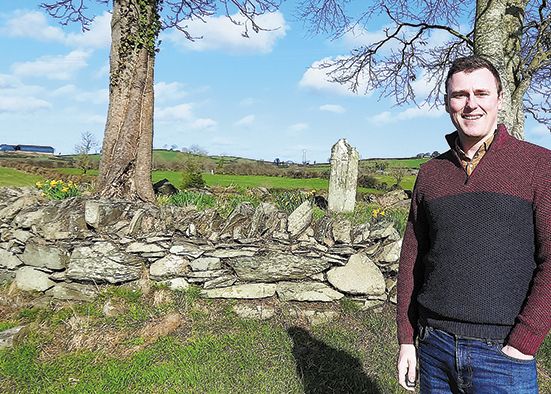Listooder burial place declared historic monument
Listooder burial place declared historic monument
24 May 2023

ONE of the earliest pieces of local history that captivated me was a wee grave beside my house near Listooder, called Killygartan.
Over the past few years, I’ve been seeking to get proper protection for
Killygartan grave and am delighted that it has now been made a ‘scheduled monument’.
The process of ‘scheduling’ is long and requires extensive documentation and research to be submitted. Below, I’d like to share with you some of the history behind this intriguing grave which my own family home is named after.
When I was a boy, I used to love visiting my next-door neighbour, Mary Killen, and hearing about all the local stories. My favourite story was always about the nearby grave.
I asked: “What’s that grave out the front of us Mrs Killen?” She replied: “That’s the priest’s grave. In penal times a priest was put into a barrel with spikes and rolled down the hill and he was buried at the bottom of the hill.”
This hill is known as Race Hill. I never knew much more than this, but in recent years it became apparent that the history of this site goes far beyond this incident.
In 1871, the historian, Fr O’Laverty wrote on the ecclesiastical history of Down: “In the townland of Listooder is a small and long disused graveyard called Killygartan, where a headstone marked with a cross is said to indicate a priest’s grave, but the alleged occupant is not remembered.”
In 1939, the Down and Connor Historical Society wrote some more: “There is a small enclosed space, called Killygartan, in the townland of Listooder, two miles from Crossgar on the road to Ballynahinch, which is generally said to be an ancient graveyard.
“A single headstone marked with a cross is locally said to commemorate the burial place of a priest who lost his life during the Penal days. He was placed inside a spiked barrel, brought up to the top of the hill above the graveyard and rolled down. His torn and lacerated body was interred at Killygartan.”
While it is the story of the priest’s grave that captures local folklore, Killygartan was a graveyard in its own right long before this. As well as the above accounts, the old OS maps dating back to the 1830s describe Killygartan as a disused graveyard.
How old Killygartan is, is unknown. However, archaeologists believe there is little doubt that this was the site of a church and graveyard dating back to medieval times or earlier.
The place name would certainly suggest this. ‘Kill’ in the placename indicates a church, although ‘gartan’ is unclear. Perhaps pertaining to the ruling McCartan clan.
It is not impossible for Killygartan to date back before the 12th century, before the parish system was introduced and churches were monastic. This comprised of a group of monks living as individuals, but sharing a small church with each other and with local people, to whom they were ministers.
Interestingly, during a heatwave a couple of years ago, I noticed distinctive rectangular shapes of longer grass in the adjacent field. There were up to a dozen rectangles plotted around a larger T-shape, possibly the church.
Personally, I believe the history of Killygartan is more significant than we realise. Perhaps Killygartan is one of the Seven Chapels of Kilmore, and, like at least one of these chapels, has a connection to St Patrick.
During Penal times, such an ancient site off the beaten track would have been ideal for reusing as a Mass site. This would be particularly plausible if the site was chosen as a place of execution and burial of a priest.
The walled enclosure around the priest’s headstone is much smaller than the original graveyard that was once used by local Catholics and Protestants, much like Kilmore’s old graveyard. Killygartan graveyard appears to have extended to the south. As the 1832 map of the area describes the graveyard as an old burial ground, this would imply the graveyard was still visible then.
No other headstones are visible now. However, I did once find an old headstone from possibly the late 18th or early 19th century on my own grounds, presumably placed here for safe keeping by a previous farmer. The only letters visible are RO - - M - -. The only possible surname that existed locally is Roseman. A credible source recently told me that he had heard the headstones were placed along the banks of the adjacent unnamed river. However, I couldn’t find any sign of this being the case.
The lovely wall around the grave today is fairly modern, and evidently constructed to protect the priest’s grave. There is a chuck of stone missing from the top of the gravestone. On 3rd July, 1898, the grave was vandalised by men from Ballynahinch during the centenary of the 1798 rebellion (more on this another time), and the wall was probably constructed shortly afterwards when the grave was repaired by permission of Lord Dunleath.
Misinformation
This eventuality in 1898 would appear to be the cause of misinformation around Killygartan, whereby some purport this priest was killed during the 1798 rebellion. However, even when the grave was vandalised in 1898, reports in both the UK and America show that it was vandalised in the knowledge of its connection with 16th-century Penal times. The Latin cross itself would suggest this era.
I like to give weight to folklore passed down by local families in particular. There is no family that has been here for hundreds of years and lives as close to Killygartan as the Killens. The late Mary Killen always referred to the Penal times and not the 1798 Rebellion. The same references to early Penal times are found in documents on the grave from the 19th and 20th centuries.
The 1798 claim was published in a memoir by St Joseph’s RC Church in 1976 with a picture of its priest kneeling at the grave. The caption reads: “Fr McCaughan, Crossgar, kneels at the stone which, local tradition says, marks the grave of the Rev Fr McCartan who was murdered during the ’98 Rebellion, at Race Hill, Cluntinaglare – 2 miles from Crossgar.”
However, I have never found any evidence for this; in fact to the contrary as aforementioned. Much older reports state the 16th century and it is likely the priest mentioned by Crossgar Chapel was Rev Fr Theophilus McCartan
(RC Bishop of Down and Connor and late of Loughinisland) whose gravestone is at Loughinisland and dated 1778 aged 78. If the name of the priest at Killygartan was not known to the County Down historian and priest, Fr O’Laverty, it is unlikely to be known 100 years later.
The grave’s current owner has done a great job at preserving this quaint grave and I would like to thank him for his assistance. He and the previous owner, William Pentland, have taken a keen interest in this grave. (Please remember that this is private land).
It is important to protect the grave for future generations. Over the past few years I have been working with Stormont’s Historic Environment Division (HED) to give the grave greater protection and enable its history to be articulated. I would like to thank HED for their cooperation. When the archaeologist first came out a couple of years ago, he described Killygartan as being a “particularly evocative sense of place”. I think so too.
Killygartan Graveyard is now one of just over 2,000 historic monuments in Northern Ireland which are classified as ‘scheduled monuments’. This means they are protected as monuments of regional importance to Northern Ireland as a whole.


